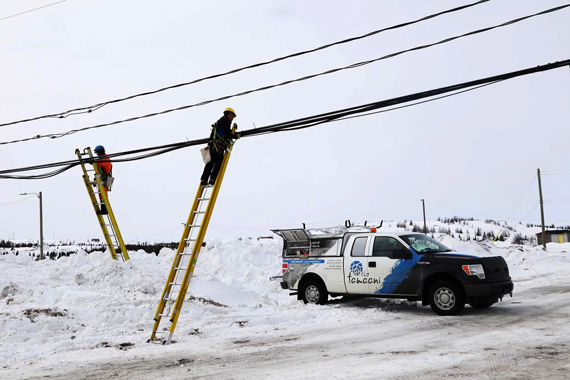More internet bandwidth is on its way to Nunavik
But full scope of the fiber project still depends on federal funds.

The Kativik Regional Government says it’s still waiting on news of federal funding that could expand its plans to deliver speedier internet through fiber-optic cables to five more Nunavik communities.
Under its current plan, the KRG’s internet provider, Tamaani, is set to lay a new underwater fiber-optic cable this summer from Chisasibi, in James Bay, north to Puvirnituq, with spurs connecting to Kuujjuaraapik, Umiujaq and Inukjuak. The cable is set to be installed and in operation by the end of 2021.
Kuujjuaq would connect to the fiber-optic network in Schefferville, Quebec, roughly 400 kilometers south via microwave towers, while the rest of the region’s communities will get increased satellite capacity.
The KRG has also applied for about $100,000 from the Canadian Radio-television and Telecommunications Commission as well as from Ottawa’s Universal Broadband Fund, said Daryl Combden, director of the KRG’s administration department, during regional council meetings in Kuujjuaq on Tuesday.
That money would allow the KRG to extend its fiber network from four to nine of Nunavik’s 14 communities, first by extending the submarine cable from Puvirnituq to Salluit, and overland to Kangiqsujuaq, and then by laying a terrestrial fiber link between Kuujjuaq and Schefferville in place of microwave towers.
The funding would also help boost satellite capacity to other Nunavik communities.
But the KRG won’t know if the region has secured that funding until mid-2021.
“We expect to hear now next summer,” Combden said at the regional council meetings.
The good news is that the region’s current fibre-optic project remains on schedule to be in operation by the end of the year, he said.
Alcatel Submarine Networks is preparing to lay the submarine cable between Puvirnituq and Chisasibi in the ice-free season of 2021.
“[The project] has not yet been hampered by COVID-19,” Combden said. “By December 2021, we expect that the submarine cable will be in service.”
The bandwidth freed up once the cable is in place should represent about 25 percent of Tamaani’s total network capacity — satellite capacity that would then be redistributed to other communities.
That will deliver much-needed bandwidth to the rest of the region, which has already reached a saturation point, Combden said.
“We can’t give any more,” he told regional councillors. “We’re giving 100 percent of what we have to give.”
In the meantime, some internet customers in both Nunavik and Nunavut have begun to pre-order Starlink’s new satellite internet service kits, which is targeting coverage in the eastern Arctic for later this year.
Elon Musk’s ambitious SpaceX project aims to build a constellation of thousands of small satellites to deliver high-speed internet across the world, through the service will first be offered in the U.S. and Canada.
But Combden said Tamaani’s own upgrades and fibre-optic network will likely be in place before Starlink is able to reach potential customers in the region.
“We welcome any other service, but it’s going to be a while yet,” he said. “It won’t be in Nunavik before mid-2022.”
Combden emphasized that he’s not worried that Starlink will take away from Tamaani’s service.
“At the end of the day, they’re bringing more bandwidth to the region, which is positive,” he said.